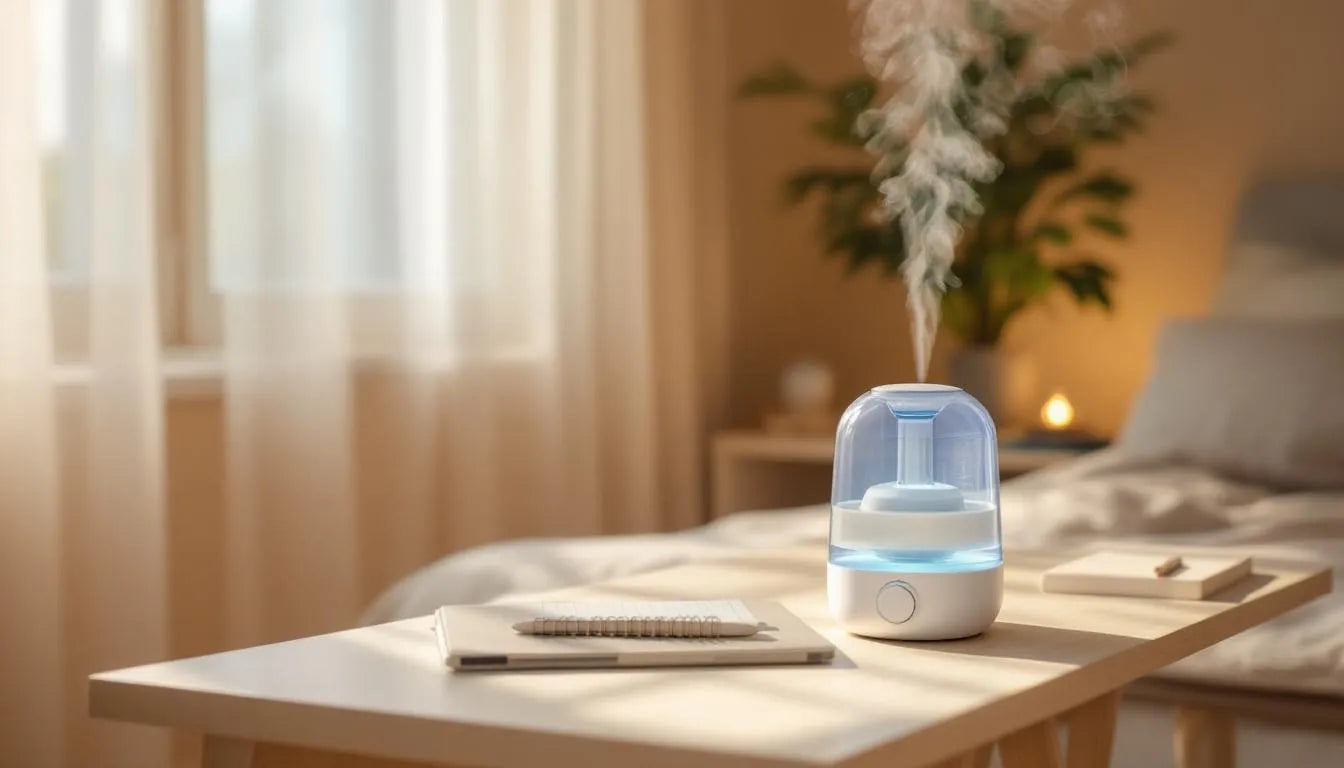⬇️ Prefer to listen instead? ⬇️

- 🌡 Mushrooms fruit reliably only when dew point and air temperature align to cause surface condensation.
- 💧 90% RH without surface moisture often fails, misleading growers into thinking conditions are ideal.
- 🌬 Airflow (FAE) is just as important as humidity for avoiding contamination and promoting pin development.
- 🛠 Common home environments have too low RH, needing artificial help for successful indoor grows.
- 🍄 Different mushroom varieties need specific humidity schedules based on their biology and environmental needs.
If you've ever had trouble getting your mushrooms to fruit indoors, you've probably heard the phrase “just keep it humid.” But that’s only half the truth. Mushroom humidity is more complex than simply running a humidifier non-stop. Successful indoor growing depends on understanding relative humidity, surface moisture, airflow, and how temperature affects condensation—especially the dew point. Using tools like monotubs or grow bags can help you control these factors more precisely. In this article, we’ll explore the real science behind mushroom humidity and show how to maintain ideal conditions for strong growth and big harvests.

The Science Behind Humidity and Mushrooms
Mushrooms need much more water than most plants. They are fungi, so they don’t have roots or leaves to take in water. Instead, they completely depend on their immediate surroundings to stay hydrated by absorbing water through their surface. So, controlling the small area around them is very important, especially when growing mushrooms indoors.
Why Surface Moisture Matters
A very important biological process for mushrooms is cutaneous respiration. This is their ability to "breathe" through their surfaces. If the area isn't moist, this process doesn't work well. Fruiting bodies can't form properly in dry conditions. And too much moisture can cause bacterial rot.
Two Key Measures of Humidity
- Relative Humidity (RH): This number, shown as a percentage, tells you how much water vapor is in the air. It compares this amount to the most water the air could hold at that temperature. For example, 90% RH means the air holds 90% of the moisture it can contain before water starts to form.
- Absolute Humidity: This is the total weight of water vapor in a certain amount of air (like grams of water per cubic meter). This number helps you know how much moisture is truly available, no matter how it changes with temperature.
Not all types of mushrooms react the same way to the same RH. For example, Lion’s Mane or Enoki need very different conditions than oysters or shiitake. But all mushrooms need moist surfaces. This means condensation, misting, or a substrate that holds moisture.

Dew Point: The Secret Ingredient to Fruiting Success
🔑 The dew point is key to creating the perfect surface conditions that start fruiting.
The dew point is the temperature where air holds all the water vapor it can, and water starts to form. For mushrooms, this isn’t just a weather fact. It's one of the most important things in the environment that cause pins to grow.
Why Air Moisture Isn’t Always Enough
People often mistakenly believe that just keeping RH at 90% guarantees success. But if the dew point isn't met, no water will form on surfaces. This leaves the surface dry, even if the air is full of moisture. And this causes pinning to stop or fruiting to fail completely.
💧 Water forming right on the substrate or block surfaces is key. This is the condition mushrooms came to expect in nature: morning dew, foggy forest floors, and wet caves.
Calculating or Estimating Dew Point
To figure out if you'll reach the dew point, watch both air temperature and RH. You can find online calculators or use devices like Govee smart hygrometers to guess the dew point automatically. Here's a quick example:
- Room air temp: 70°F (21°C)
- RH: 90%
- Dew Point: ~67°F (19.5°C)
If the FRUITING BLOCK is cooler than 67°F, you’ll see condensation; if it’s warmer, you won’t—even though RH is high.
🧪 The American Mushroom Institute says, "keeping condensation on the surface of fruiting blocks—without water pooling—is very important for breathing and for pins to form well" (American Mushroom Institute, 2021).

Ideal Humidity Ranges by Growth Phase
Mushrooms go through many growth stages. Each stage needs a different RH level and slightly different conditions.
| Growth Phase | Optimal RH | Additional Notes |
|---|---|---|
| Colonization | 60–75% | Lower RH prevents contamination and pins forming too early |
| Primordia Formation | 90–95% | Dew point must be met for pins to form well |
| Fruiting | 85–90% | Keep surface moist and have plenty of fresh air movement |
| Post-Harvest Flush Prep | 70–80% | Lower RH a little to reduce contamination and get ready for the 2nd flush |
ℹ️ Too much RH during colonization can cause mold to grow (like Trichoderma). But too little during pinning prevents water from forming and makes fruiting take longer.

Monitoring the Microclimate: Tools & Devices
You’ll need more than just a gut feeling to get the perfect conditions right every time, especially when growing mushrooms indoors. Being exact helps you succeed.
Recommended Devices
- Thermohygrometers: Show both temperature and RH.
- IR Thermometers: Check the surface temperature of your grow block against the air temperature. This is very important for watching the dew point.
- Data Loggers: These are good for tracking changes over time and making future grows better.
- Salt Test Method: Keep your hygrometers accurate by checking them regularly. Do this by placing them in a sealed container with a salt and water mix.
📈 The goal is stable RH and temps—not just a quick spike. Peaks and drops can cause pins to stop growing or slow mycelial growth.

Smart Tools That Actually Help (Especially Indoors)
Controlling humidity in closed home spaces might need clever solutions or tools with technology.
Devices That Change the Game
- Ultrasonic Humidifiers: Make a fine mist that increases humidity without making substrates wet.
- Inline Fans or PC Fans: Give steady fresh air movement (FAE). This is very important to stop CO₂ from building up.
- Inkbird Humidity Controllers: Automatically turn humidifiers on and off to keep RH levels exact.
- Grow Chambers/Tents: Help you control conditions better. They do this by separating your small growing area from the drier air in your home.
🏠 The EPA says that indoor air usually has 30%–50% RH. This is far too low for growing mushrooms successfully without a lot of extra help (EPA, 2020).

Hidden Places for Mushroom Growing Indoors
No grow room? No problem. Many common places in your home can be great small growing areas when set up right.
- Basement Corners: These are naturally cool and have steady humidity.
- Under-Stair Closets: Small and easy to control for temperature and RH.
- Bathrooms: Already humid. These are great for mushroom tents with extra air flow.
- Garages with Insulation: These can become grow spaces using heaters and tools to control humidity.
- Closet Tents: Put plastic on shelves and keep kits on raised racks for better airflow.
🌡 Pro Tip: Keep your mushroom grow station away from HVAC vents or windows that get sun. This will help you avoid sudden changes in conditions.

Common Humidity Problems and Fixes
Let’s troubleshoot what goes wrong even when you think you’re “doing everything right.”
Too Dry
Symptoms:
- Shrinking, leathery mushrooms
- Cracked caps
- Underdeveloped pins or aborted pins
Fixes:
- Increase RH
- Use misting sprayers closer to substrate or grow block
- Place blocks in sealed tents or chambers
Too Wet
Symptoms:
Fixes:
- Improve airflow
- Raise blocks, allow water to drain
- Dial back misting or use finer mist particles
Inconsistent RH
Symptoms:
- Sudden changes in conditions
- Fruits that are not even or are shaped wrong
- Weak mycelial structure
Fixes:
- Use automated controllers
- Insulate tent space
- Avoid opening tent unnecessarily

Environmental Factors That Impact Indoor Grow Setups
Even subtle changes in room behavior can make or break your grow.
HVAC and Seasonal Effects
- Winter Heat: Makes indoor air RH drop as low as 15–20%. Use extra humidifiers and wetting specific spots.
- Air Conditioning: Dries air while cooling. Watch RH all the time or use two-stage timers.
- Ventilation/Ducting: Good for homes, but it pulls moisture from your small growing area. Keep grow areas separate from the main air currents.
Geography Matters Too
- Auckland, New Zealand: High air RH means easier indoor growth.
- Phoenix, Arizona or Calgary, Canada: Very dry places need a lot of misting, moisture traps, and sealed setups.

Surface Moisture vs. Air Moisture: What Actually Matters
Condensation is king. Surfaces—not air—are what your mushrooms interact with directly. If your substrate is dry, air moisture help isn’t reaching your mushrooms.
Best Practices
- Mist close to fruiting blocks (preferably under 3 feet).
- Use filtered, distilled water to stop minerals from building up.
- Wipe inside grow tent walls to stop bacteria from growing.
- Don’t mist too much. Aim for that gentle, pearl-like “shimmer,” not wet puddles.
🕵️♀️ Watch for signs: Mushroom caps should glisten slightly. Dull, matte caps = too dry.

Case Study: Fruiting Block Comparison Based on Humidity Strategy
Two cultivators tested oyster blocks in two settings over a 5-day period.
-
Room A: 75% RH, same temp. No condensation formed.
🧪 Outcome: Weak pins, growth was slow, and edges dried out. Only 30% of the possible yield. -
Room B: 90% RH and cooler block surface (dew point met).
🧪 Outcome: Healthy pin sets in 48 hours. Deep color, caps grew evenly. Over 90% of the possible yield.
The key variable? Surface condensation based on dew point in Room B.

Humidity Techniques for Specific Mushroom Varieties
Every species has different water needs. So, your method should show this.
- Oyster Mushrooms: Grow well in constant, swirling air and high RH (85–95%).
- Shiitake: Likes drier colonization. Then, give it a soak or a cold shock, followed by 80–90% RH for fruiting.
- Lion’s Mane: Needs surfaces to be moist almost all the time. Use grow domes or tents with a lot of mist.
- Enoki: Grows best in low-temperature, high-RH places. It does well with regular misting.
🍄 Get to know your species. Look at grow logs or community forums for advice for specific conditions.
Rethinking Humidity for Happier Mushrooms
Mushroom humidity needs a mix of science and watching closely. It’s not just about spraying mist everywhere. It’s about making an environment that reacts to what mushrooms really need: moist surfaces, air flow, knowing the dew point, and care for each stage.
When you understand these ideas, growing mushrooms indoors becomes less mysterious and more reliable.
Citations
- American Mushroom Institute. (2021). Growing high-quality mushrooms: Best practices for environmental controls.
- United States Environmental Protection Agency (EPA). (2020). Indoor Air Quality: Humidity & Moisture Control for Healthier Homes.
- Stamets, P., & Chilton, J. S. (1983). The Mushroom Cultivator: A Practical Guide to Growing Mushrooms at Home. Olympia, WA: Agarikon Press.



